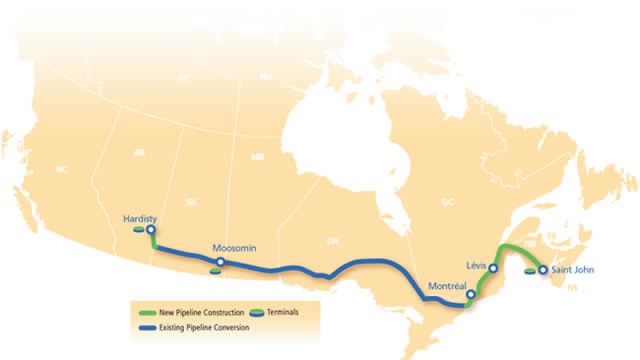Calgary – TransCanada gave up on its proposed $15.7 billion Energy East Pipeline project on Oct. 5 after four years of trying to jump through regulatory hoops In January, the NEB process was reset after concerns about lobbying efforts, a major step back. Then those hoops got even tougher when the National Energy Board announced changes to how it will evaluate carbon footprints on pipelines.
In September, TransCanada suspended its application. Now, it’s dead. So is the Eastern Mainline project.
Energy East would have repurposed a 42 inch pipeline that had been used for natural gas delivery from Alberta to Ontario as part of its multi-pipeline mainline system. Since the price of natural gas has been in a funk for roughly a decade now, gas production in Alberta has declined and deliveries through the mainline have dropped in turn. This left the mainline system running substantially under capacity. Converting one pipeline to oil transportation, as TransCanada did with its original Keystone XL pipeline (which makes a right turn in Manitoba into the United States Midwest)., would have brought new life to the mainline.
A new mainline would have been built through Quebec and New Brunswick, extending the reach of the existing pipe.
The 1.1 million barrel per day pipeline would have supplied Central and Eastern Canadian refineries with oil from Alberta, Saskatchewan and Manitoba. These refineries are currently processing imported oil from overseas, including Saudi Arabia and Nigeria. With Western Canadian oil supplanting imports, it would have allowed all of Canada to be energy independent from the rest of the world with respect to oil.
The terminus of the pipeline would have been the Irving Refinery and Saint John, New Brunswick, allowing Western Canadian oil to “reach tidewater” and thus demand prices more in line with the international Brent benchmark, as opposed to the often-discounted West Texas Intermediate benchmark.
For Saskatchewan, Energy East would have allowed new markets, especially for southeast Saskatchewan. Currently, all oil produced in southeast Saskatchewan that doesn’t go by rail (and rail is hardly used these days), flows through the TEML Westspur system to Cromer, Man. From there it joins the Enbridge Mainline, running into the American Midwest. Energy East would have included a new three-tank terminal northeast of Moosomin, and a connecting pipeline to Cromer known as the Cromer Lateral. That 16 inch pipeline would have had the capacity to take every drop of southeast Saskatchewan oil onto Energy East, if producers chose to use that pipeline instead of Enbridge’s mainline. The result would have been diversified market opportunities for Saskatchewan oil, including the possibility of international export to overseas buyers.
Additionally, TransCanada had proposed another pipeline, the Upland Pipeline, that would have run from Williston, N.D., to Northgate, Saskatchewan, and from there to either Cromer or Moosomin. Upland would have allowed North Dakota oil to access the same eastern markets via Energy East, including international exports. With Energy East dead, it takes Upland with it.
TransCanada President and Chief Executive Officer Russ Girling said in a release, “After careful review of changed circumstances, we will be informing the National Energy Board that we will no longer be proceeding with our Energy East and Eastern Mainline applications. TransCanada will also notify Quebec's Ministère du Developpement durable, de l'Environnement, et Lutte contre les changements climatiques that it is withdrawing the Energy East project from the environmental review process.
“We appreciate and are thankful for the support of labour, business and manufacturing organizations, industry, our customers, Irving Oil, various governments, and the approximately 200 municipalities who passed resolutions in favour of the projects. Most of all, we thank Canadians across the country who contributed towards the development of these initiatives.
“We will continue to focus on our $24 billion near-term capital program which is expected to generate growth in earnings and cash flow to support an expected annual dividend growth rate at the upper end of an eight to 10 per cent range through 2020.”
As a result of its decision not to proceed with the proposed projects, TransCanada is reviewing its approximate $1.3 billion carrying value, including allowance for funds used during construction (AFUDC) capitalized since inception and expects an estimated $1 billion after-tax non-cash charge will be recorded in the company's fourth quarter results. TransCanada stopped capitalizing AFUDC on the project effective August 23, 2017, as disclosed on September 7, 2017. In light of the project's inability to reach a regulatory decision, no recoveries of costs from third parties are expected.
����




